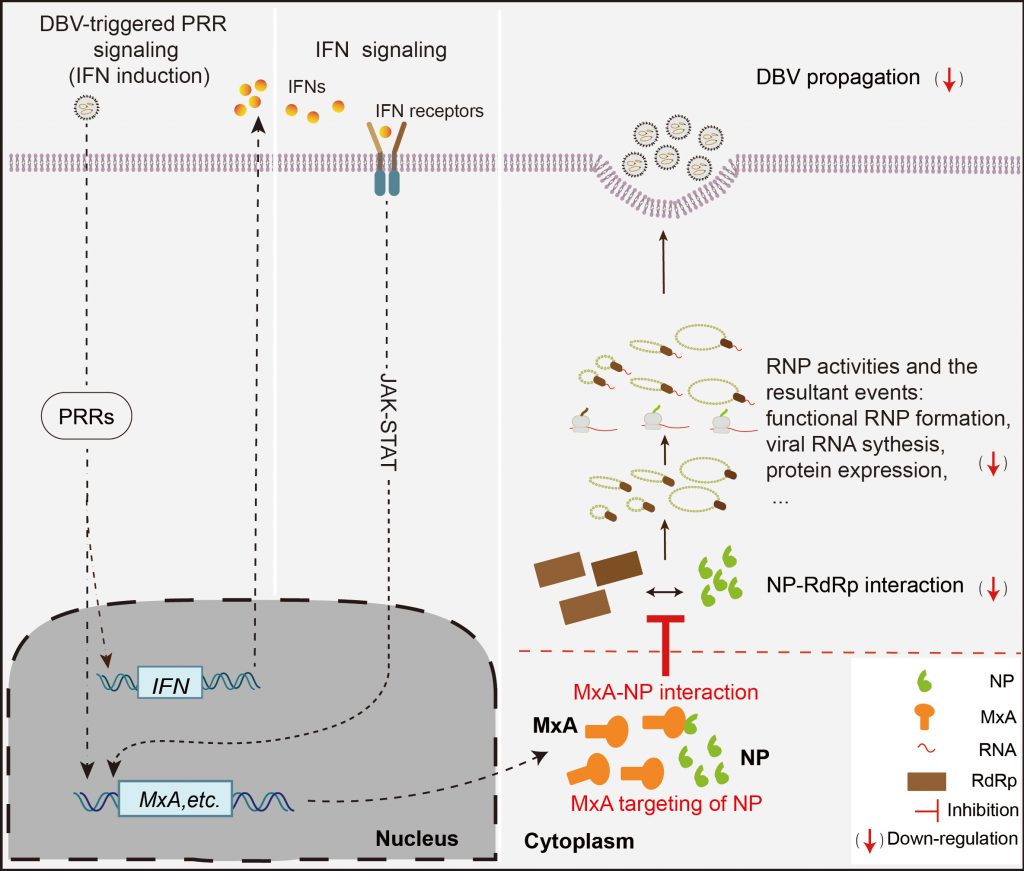Recently, the team of Wang Hualin, Deng Fei, and Ning Yunjia from the Chinese Academy of Sciences Wuhan Virology Research Institute/National Viral Resource Bank published the research papers titled “Interactome profiling of Crimean-Congo hemorrhagic fever virus glycoproteins” and “Host factor MxA restricts Dabie bandavirus infection by targeting the viral NP protein to inhibit NP-RdRp interaction and ribonucleoprotein activity”. The above research elucidates new interaction mechanisms between the virus and host cells of two highly pathogenic Bunyaviruses, CCHFV and SFTSV, expanding our understanding of virus infection replication and host antiviral response mechanisms.
Crimean Congo Hemorrhagic Fever Virus (CCHFV) and Dabie Banda Virus (also known as Fever with Thrombocytopenia Syndrome Virus or SFTSV) are highly pathogenic pathogens prevalent from natural sources. At present, there are no specific drugs or vaccines targeting these pathogens, and the infection and replication mechanism of the virus also needs further research.
Our Featured Products
Cat. No. |
Product Name |
Source |
Species |
Tag |
| N-5702B | Recombinant Bunyavirus La Crosse N protein, His-tagged | Bunyavirus La Crosse | Yeast | |
| N-5701B | Recombinant Bunyavirus La Crosse N protein, His-tagged | Bunyavirus La Crosse | Yeast | |
| HAX1-13677H | Recombinant Human HAX1, GST-tagged | E.coli | Human | GST |
| HAX1-7525H | Recombinant Human HAX1, His-tagged | E.coli | Human | His |
| HAX1-486Z | Recombinant Zebrafish HAX1 | Mammalian Cell | Zebrafish | His |
| HAX1-2797R | Recombinant Rat HAX1 Protein | Mammalian Cell | Rat | His |
| HAX1-2039R | Recombinant Rhesus monkey HAX1 Protein, His-tagged | Mammalian Cell | Rhesus Macaque | His |
| HAX1-4592H | Recombinant Human HAX1 Protein, GST-tagged | Wheat Germ | Human | GST |
During the viral infection process, the virus’s protein machine inevitably undergoes a series of complex interactions with the host cell. These interactions may affect the infection and host response processes of the virus to varying degrees. The team analyzed and drew a network diagram of the interaction between CCHFV’s membrane glycoprotein (GP) and cells, and based on this diagram, proposed a series of host processes that may affect viral glycoproteins or be influenced by viral glycoproteins; Taking HAX1 as an example, a new mechanism of host regulation of viral glycoprotein function was analyzed.

HAX1 can interact with viral glycoproteins through its C-terminus and hijack viral glycoproteins to mitochondria using its N-terminus localization signal, thereby interfering with the Golgi aggregation of viral glycoproteins, inhibiting viral glycoprotein-mediated offspring assembly and proliferation, and limiting CCHFV infection. In addition, based on the previous multi-omics analysis of viral infection, it was found that HAX1 expression is significantly upregulated in CCHFV-infected cells, which may further enhance its antiviral effect.
The team, based on the interaction map between the SFTSV replication machine (ribonucleoprotein) and the host constructed earlier, analyzed the molecular mechanism by which the host factor MxA restricts virus replication, expanding new understanding of the antiviral mechanism of MxA – MxA can target the capsid protein NP of SFTSV through its N-terminal, inhibit the interaction between NP and polymerase machine, and block the transcriptional replication activity of the virus replication machine. In recent years, the team has identified other host factors that can also target virus replication machines, such as MOV10 and DDX1, indicating that the replication machine of Bunyavirus may be an important target for host antiviral response. The above achievements have expanded scientists’ understanding of the virus-host interaction mechanism, or provided new clues and ideas for the development of antiviral intervention drugs.
Related Services